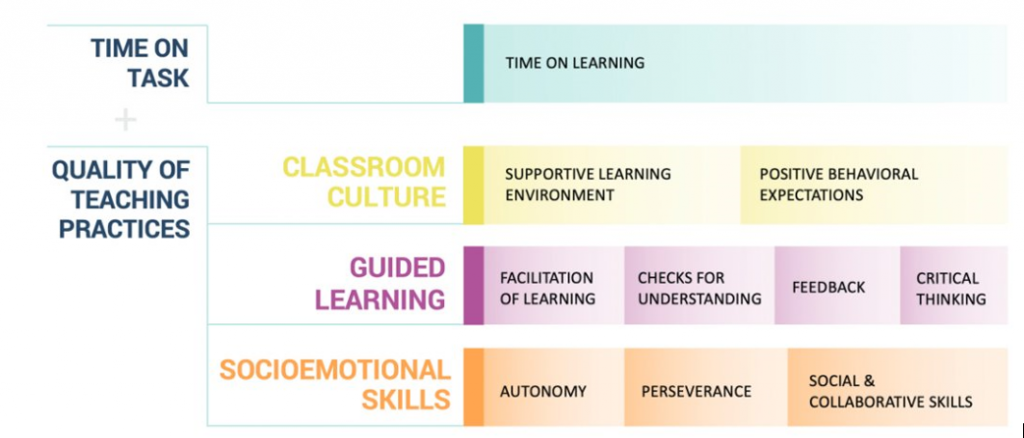 The scale-up of ECE globally presents both an opportunity and challenge in ensuring children are reaping the benefits and the promise of the early years.
The scale-up of ECE globally presents both an opportunity and challenge in ensuring children are reaping the benefits and the promise of the early years.
Globally, access to early childhood education (ECE) has been expanding rapidly (Figure 1), with the most dramatic increases occurring in low- and middle-income countries (LMICs). However, we know that even when children are in school, schooling is not the same as learning. This can be seen in the paradox of high levels of learning poverty despite near-universal primary enrollment rates. We cannot allow this trade-off between access and quality to continue.
Figure 1: Enrollment rates in ECE by region
Evidence shows that ECE sets a strong foundation for later learning, helps make education systems more effective and efficient, and is an effective strategy for promoting economic growth as it reduces achievement gaps and inequities and builds skills for future employment (for an overview of the evidence, see, for example, Chapter 5 of the 2018 World Development Report or Chapter 5 of the OECD’s 2017 Starting Strong report). Yet, none of these promises can be realized without an emphasis on quality alongside access.
In the research literature, quality of ECE is often divided into structural and process quality. Structural quality refers to inputs such as aspects of the physical environment (e.g., infrastructure), group characteristics (e.g., adult-child ratios), and caregiver or teacher variables (e.g., initial education and training). Process quality, on the other hand, refers to the interactions with teachers, peers, and materials that children experience in ECE settings – in essence, the children’s learning experience.
In scaling up ECE, countries tend to focus on aspects of structural rather than process quality. For example, teacher-child ratios are often used as an indicator within ECE quality standards. It is critical to invest in structural quality, as some level of structural quality is necessary for process quality. However, structural quality is not sufficient to guarantee process quality. Globally, there is almost no systematic data on process quality. Without this information, countries are ”flying blind” in their efforts to scale up quality ECE.
When discussing how to scale up process quality alongside structural quality and access to ECE, the conversation needs to center on the ECE workforce. This is because the quality of the ECE educator is a key determinant of the quality of children’s learning experiences in the classroom. However, the global ECE workforce faces many challenges – there aren’t enough teachers to meet the target of universal enrolment in ECE, these teachers are faced with a lack of parity in pay and in conditions of service with primary school teachers, and ECE teachers often do not have access to opportunities for professional development, to name only a few (see Chapter 3 in UNICEF’s 2019 A World Ready to Learn report). These issues will need to be tackled from multiple fronts.
One key entry point to improving process quality and better supporting the ECE workforce is through measurement, because – like most things – we can’t fix what we don’t know or understand. Standardized measurement of ECE classroom quality can provide a common language to drive policy dialogue on the importance of focusing on quality alongside access. It can help create a shared understanding of what quality ECE entails, which can feed into quality standards and regulatory mechanisms. It can shed light on the critical role that ECE teachers play in scaling up quality ECE, and help shape interventions aimed at improving ECE quality, particularly those focused on teacher training and support.
This why we recently launched Teach ECE to support measurement of ECE process quality at scale. Teach ECE is a free, open-source classroom observation tool that has an explicit focus on both (i) the time ECE teachers spend on learning activities and the extent to which children are on task during those learning activities, and (ii) the quality of ECE teaching practices that help develop children´s cognitive and socioemotional skills (see Figure 1). Teach ECE also measures cross-cutting themes throughout its different behaviors, such as inclusion, language facilitation, and child-centered teaching practices.
Figure 1: Teach ECE Framework
Teach ECE is available in English, French, Portuguese, Spanish, and Arabic, and is accompanied by a suite of resources, including materials to support stakeholder consultations, resources to support video collection, sourcing, and coding, scripted training materials to support enumerator training, and resources to support data cleaning and analysis. There is also an accompanying literature review that provides the theoretical and empirical evidence on the effective ECE teaching practices captured in Teach ECE, drawing from evidence-based teaching practices from countries around the world.
Teach ECE aligns with Teach Primary, a classroom observation tool developed for primary classrooms, launched in 2019 and applied in over 20 countries to date. This alignment facilitates measurement of process quality across different education levels. The team is also in the process of developing Teach Secondary.
The scale-up of ECE globally presents both an opportunity and challenge in ensuring children are reaping the benefits and the promise of the early years. We hope that Teach ECE will support education systems to capture the quality of teaching practices in ECE classrooms and contribute to longer term efforts to make ECE teacher professional development more ongoing, practical, focused, and tailored to the needs of teachers, thus ensuring that ECE teachers receive the support they need to ensure that all children have access to quality ECE.
If you missed the launch of Teach ECE, re-watch it here to see a presentation on Teach ECE, which covers what the tool captures, available resources to support implementation, and initial findings from pilot applications. The presentation is followed by a panel discussion featuring Nirmala Rao (University of Hong Kong), Janeli Kotzé (Ministry of Education, South Africa), and Ingrid Bjerke (World Bank) on best practices around measuring and supporting effective teaching in the ECE classroom, drawing on perspectives from the field, research, and policy.
Also, we’d love to hear from you! Do you have ideas or suggestions for us? Would you like to implement Teach ECE in your context? Are you responsible for ECE teacher professional development in your country/region? Contact us with your suggestions, comments, and ideas for collaboration at teach@worldbank.org.





Join the Conversation